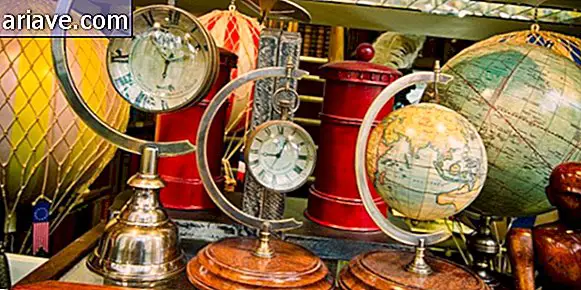Discover some of the unique pieces destroyed in the National Museum fire
In the late afternoon of Sunday, September 2, 2018, the National Museum of Rio de Janeiro, which is linked to the Federal University of Rio de Janeiro, caught fire after the end of visiting hours. The fire spread over the three floors of the historic mansion called Palacio de Sao Cristovao, which housed the Portuguese royal family - and later the Brazilian imperial family - from 1808 to 1892, when it started to host the National Museum, founded exactly 200 years ago.
The institution housed an impressive collection of 20 million pieces - divided between the areas of anthropology, botany, entomology, geology and paleontology, and of which about 3, 000 were exposed to the public - a library with over 474, 000 volumes, including books, periodicals and other publications on the natural sciences, and around 2, 400 rare works.
Check out the most important pieces that were stored in the National Museum of Rio de Janeiro:
Dinosaurs
The National Museum of Rio de Janeiro housed in its collection the fossils of Maxakalisaurus topai, the first large dinosaur found and assembled in Brazil. It was a herbivorous animal about 13 meters long and 9 tons. The fossils that allowed the discovery of this dinosaur were found in the state of Minas Gerais, Serra da Boa Vista, near the city of Prata, which earned him the popular name of "dinoprata",
In addition to the museum housing the original Maxakalisaurus topai fossils, it displayed to the public a perfect replica of the animal's skeleton, as well as other fossils of other species known to paleontology, all discovered in Brazilian archaeological sites and important to portray which of these animals walked the soil that today constitutes Brazil.

Dom Pedro II Throne Room
In the room were also furniture similar to those of the time that were lent to the museum
The São Cristóvão Palace, which hosted the National Museum, previously served as the residence of the Brazilian imperial family. There was born the emperor Dom Pedro II, who ruled Brazil from 1831 until the Proclamation of the Republic in 1889, and in that same place was the famous throne room, where the monarch's famous kissing ceremony took place.
The museum kept one of Dom Pedro II's thrones in the room and emphasized the unparalleled painting of the room's walls: it created a special, high relief illusion created by the Italian painter Mario Bragaldi. In the room were also furniture similar to those of the time that were lent to the museum to imitate the original furniture of the time.

Egyptian collection
Dom Pedro II was a great admirer of natural sciences and history and a great collector of artifacts that went back to ancient Egypt. Among those in the National Museum was the coffin of Sha-amun-em-su, a singer / priestess who lived around 750 BC in Egypt and died at the age of 50. The Brazilian emperor won the coffin of the Ismail kediva - a kind of local sovereign during the Ottoman Empire - on a visit to the African country. He gave him a book about Brazil in return.
Also in the National Museum were about 700 pieces of Egyptian archeology, the largest and most important collection of this area in Latin America.
The coffin was kept in the emperor's office until its overthrow with the Proclamation of the Republic in 1889 and has since become part of the museum's collection. Dom Pedro II is said to have cherished this piece so much that he even exchanged a few words with it when alone in his office. The play had gone through analyzes of all kinds for a better understanding of the society of the ancient Egyptians.
Also in the National Museum before its fire were a golden mask dating from 304 BC, a period known as the Ptolemaic; the Stela of Ray, from 1, 300 to 1, 200 BC; Princess Kherima's mummy, which is a rare method of mummification with only eight other examples in the world and about 700 pieces of Egyptian archeology, the largest and most important collection of this area in Latin America, which was started by Dom Pedro I and expanded by your son and heir.

Dahomey Throne
Many other objects helped to tell the story of the African peoples, especially those brought into force by the slavery regime.
Also with about 700 items, the African and Afro-Brazilian ethnology collection was one of the highlights of the National Museum. Among the most prominent pieces is the Throne of Dahomey, a gift from King Adandozan, from the former kingdom of Dahomey - where today is Benin in Africa - to the then King of Portugal and Brazil, Dom João VI. It is a replica of the throne of Adandozan's grandfather, King Kpengla. The play dated from the late eighteenth century.
In addition to the throne, the museum also featured everyday objects from African kingdoms, ritual masks, musical instruments, hunting and fighting weapons, and a Dahomey war flag. Many other objects helped to tell the story of the African peoples, especially those that were forcibly brought under the slavery regime that lasted until 1888 in Brazil and are an important and inseparable part of our country's culture.

Luzia
Perhaps the most unique and important item in the National Museum was the Luzia fossil, one of the oldest human skeletons ever found in the Americas and certainly the oldest in Brazil, around 11, 500 years old. Luzia was found in Lagoa Santa, near Belo Horizonte, Minas Gerais, in 1975 by a group of Brazilian and French archaeologists. It was named after archaeologist Walter Neves after Lucy, the 3.5 million-year-old australopithecus fossil found in Ethiopia a year earlier. It would be our Brazilian version of the oldest human inhabitant of our territory.
The discovery of Luzia is undoubtedly one of the most important milestones for understanding the human occupation of the Americas.
The discovery of Luzia made many scholars review his theories of human occupation of the Americas, as his features, according to analyzes of various kinds, show that the skeleton he found belonged to a young woman more similar to African blacks or Aboriginal Australians, unlike Mongoloid peoples who originally arrived in North America from Siberia via the Bering Strait.
The discovery of Luzia is undoubtedly one of the most important milestones for understanding the human occupation of the Americas and, therefore, for the anthropology of the world as a whole. The loss of the fossils that made up its skeleton is gigantic for the world of natural science and, of course, culture as a whole.

Bendegó Meteorite
The only highlight of the museum that has so far been known to have survived the fire is the Bendegó meteorite, or Bendegó rock, the largest meteorite ever found on Brazilian soil. He was found in 1784 by a boy, Domingos da Motta Botelho, on a farm near what is today the city of Monte Santo, in the Bahia countryside.
Its survival from the museum fire, however, is not surprising, as the meteorite withstood extremely high temperatures upon its entry into the atmosphere.
The piece is considered the 16th largest meteorite ever found in the world and weighs just over 5 tons. It is mainly composed of iron and nickel and measures 2.2 meters by 1.45 meters by 58 centimeters. It was Dom Pedro II who learned of the object in 1886 and sent a commission of engineers to transport the stone to the capital.
Its survival from the museum's fire, however, is not surprising, as the meteorite withstood very high temperatures upon its entry into the earth's atmosphere and many other trials by those who studied it in an attempt to remove bits for more detailed analysis.

.....
Without a doubt, it is impossible to calculate the size of the loss caused by the fire of the Rio de Janeiro National Museum. There are 200 years of history burned by the neglect of the authorities responsible for producing culture in Brazil and, as popular wisdom says, a country without history is, unfortunately, a country with no future.











